Activity-Based Costing vs Traditional Costing: A Comprehensive Report
VerifiedAdded on 2023/06/03
|9
|1563
|324
Report
AI Summary
This report provides a comparative analysis of traditional absorption costing and activity-based costing (ABC) methods, highlighting their differences in cost allocation. Traditional methods use estimated overhead rates based on budgeted production hours, often ignoring the specific resource consumption of different products. In contrast, ABC uses cost drivers to allocate costs more precisely, focusing on the activities that cause overhead expenses, such as machine setups or quality checks. A numerical example illustrates the application of both methods, revealing that ABC leads to more realistic cost allocations by reflecting the actual overhead borne by each product. While ABC implementation can be expensive and complex, its advantages, including better cost analysis and improved pricing decisions, often outweigh the costs. The report concludes that ABC provides a more rational basis for cost allocation, enabling better management of resources and profits, but its adoption should be based on a cost-benefit analysis.
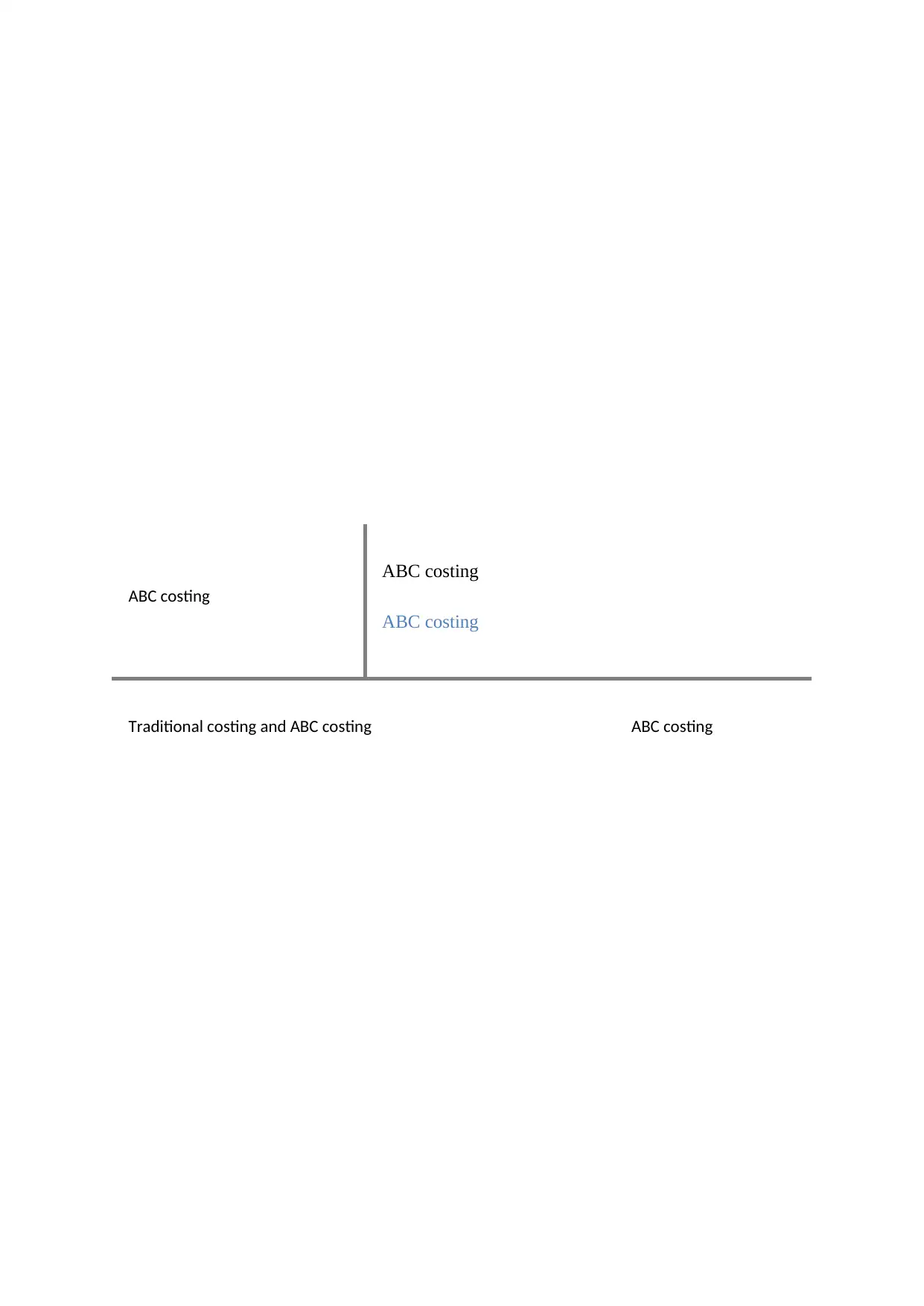
ABC costing
ABC costing
ABC costing
Traditional costing and ABC costing ABC costing
ABC costing
ABC costing
Traditional costing and ABC costing ABC costing
Paraphrase This Document
Need a fresh take? Get an instant paraphrase of this document with our AI Paraphraser
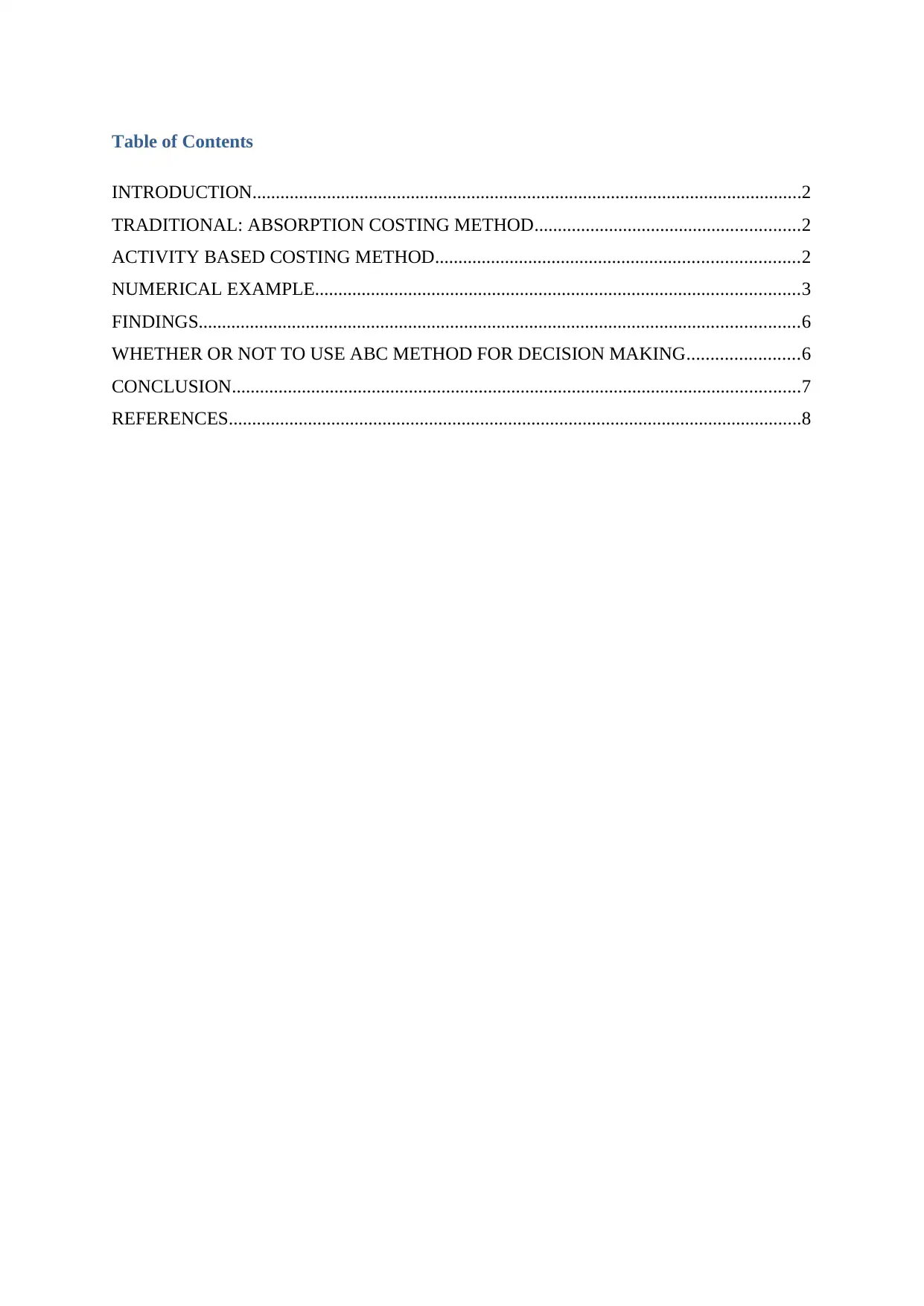
Table of Contents
INTRODUCTION......................................................................................................................2
TRADITIONAL: ABSORPTION COSTING METHOD.........................................................2
ACTIVITY BASED COSTING METHOD..............................................................................2
NUMERICAL EXAMPLE........................................................................................................3
FINDINGS.................................................................................................................................6
WHETHER OR NOT TO USE ABC METHOD FOR DECISION MAKING........................6
CONCLUSION..........................................................................................................................7
REFERENCES...........................................................................................................................8
INTRODUCTION......................................................................................................................2
TRADITIONAL: ABSORPTION COSTING METHOD.........................................................2
ACTIVITY BASED COSTING METHOD..............................................................................2
NUMERICAL EXAMPLE........................................................................................................3
FINDINGS.................................................................................................................................6
WHETHER OR NOT TO USE ABC METHOD FOR DECISION MAKING........................6
CONCLUSION..........................................................................................................................7
REFERENCES...........................................................................................................................8
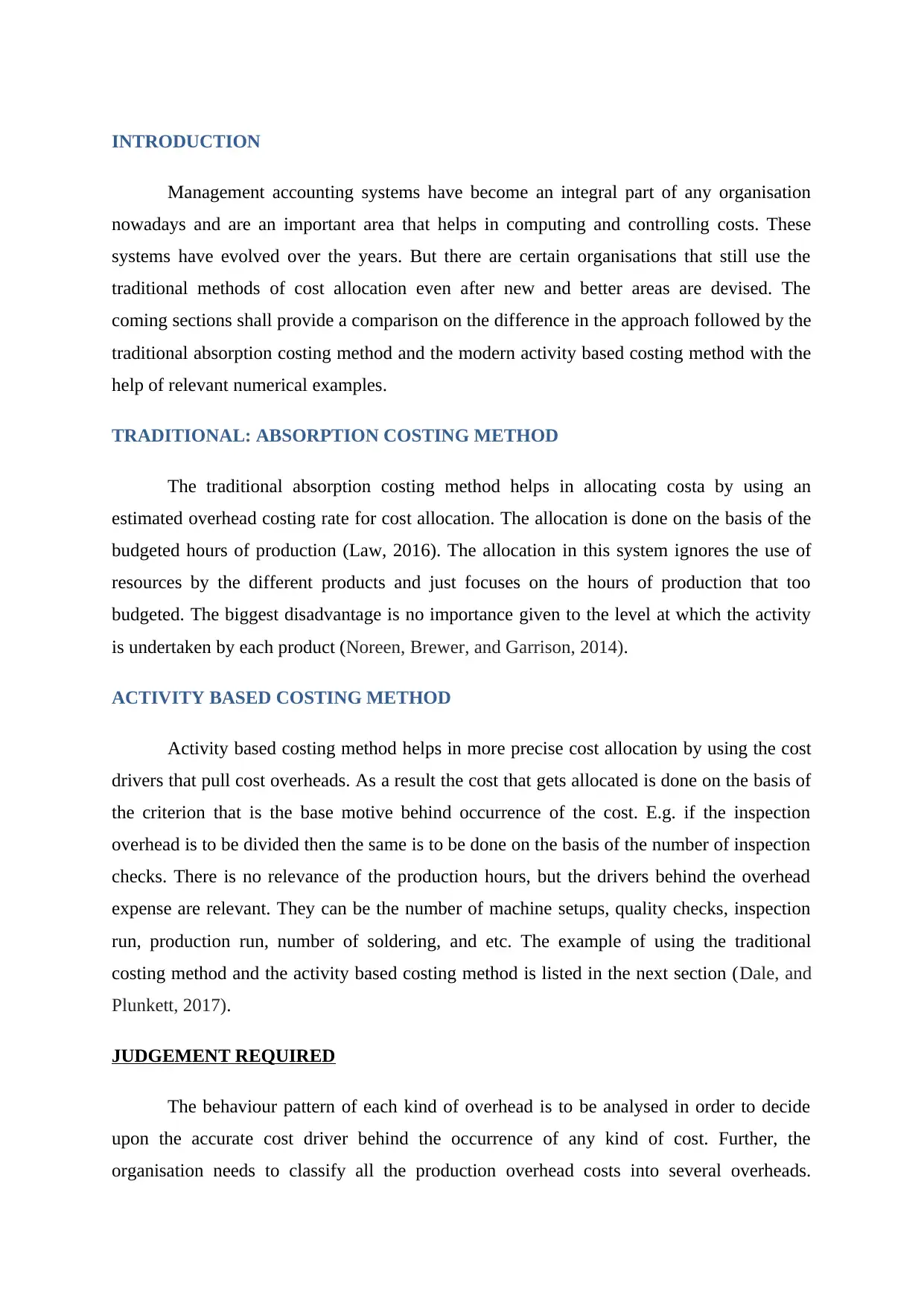
INTRODUCTION
Management accounting systems have become an integral part of any organisation
nowadays and are an important area that helps in computing and controlling costs. These
systems have evolved over the years. But there are certain organisations that still use the
traditional methods of cost allocation even after new and better areas are devised. The
coming sections shall provide a comparison on the difference in the approach followed by the
traditional absorption costing method and the modern activity based costing method with the
help of relevant numerical examples.
TRADITIONAL: ABSORPTION COSTING METHOD
The traditional absorption costing method helps in allocating costa by using an
estimated overhead costing rate for cost allocation. The allocation is done on the basis of the
budgeted hours of production (Law, 2016). The allocation in this system ignores the use of
resources by the different products and just focuses on the hours of production that too
budgeted. The biggest disadvantage is no importance given to the level at which the activity
is undertaken by each product (Noreen, Brewer, and Garrison, 2014).
ACTIVITY BASED COSTING METHOD
Activity based costing method helps in more precise cost allocation by using the cost
drivers that pull cost overheads. As a result the cost that gets allocated is done on the basis of
the criterion that is the base motive behind occurrence of the cost. E.g. if the inspection
overhead is to be divided then the same is to be done on the basis of the number of inspection
checks. There is no relevance of the production hours, but the drivers behind the overhead
expense are relevant. They can be the number of machine setups, quality checks, inspection
run, production run, number of soldering, and etc. The example of using the traditional
costing method and the activity based costing method is listed in the next section (Dale, and
Plunkett, 2017).
JUDGEMENT REQUIRED
The behaviour pattern of each kind of overhead is to be analysed in order to decide
upon the accurate cost driver behind the occurrence of any kind of cost. Further, the
organisation needs to classify all the production overhead costs into several overheads.
Management accounting systems have become an integral part of any organisation
nowadays and are an important area that helps in computing and controlling costs. These
systems have evolved over the years. But there are certain organisations that still use the
traditional methods of cost allocation even after new and better areas are devised. The
coming sections shall provide a comparison on the difference in the approach followed by the
traditional absorption costing method and the modern activity based costing method with the
help of relevant numerical examples.
TRADITIONAL: ABSORPTION COSTING METHOD
The traditional absorption costing method helps in allocating costa by using an
estimated overhead costing rate for cost allocation. The allocation is done on the basis of the
budgeted hours of production (Law, 2016). The allocation in this system ignores the use of
resources by the different products and just focuses on the hours of production that too
budgeted. The biggest disadvantage is no importance given to the level at which the activity
is undertaken by each product (Noreen, Brewer, and Garrison, 2014).
ACTIVITY BASED COSTING METHOD
Activity based costing method helps in more precise cost allocation by using the cost
drivers that pull cost overheads. As a result the cost that gets allocated is done on the basis of
the criterion that is the base motive behind occurrence of the cost. E.g. if the inspection
overhead is to be divided then the same is to be done on the basis of the number of inspection
checks. There is no relevance of the production hours, but the drivers behind the overhead
expense are relevant. They can be the number of machine setups, quality checks, inspection
run, production run, number of soldering, and etc. The example of using the traditional
costing method and the activity based costing method is listed in the next section (Dale, and
Plunkett, 2017).
JUDGEMENT REQUIRED
The behaviour pattern of each kind of overhead is to be analysed in order to decide
upon the accurate cost driver behind the occurrence of any kind of cost. Further, the
organisation needs to classify all the production overhead costs into several overheads.
⊘ This is a preview!⊘
Do you want full access?
Subscribe today to unlock all pages.

Trusted by 1+ million students worldwide
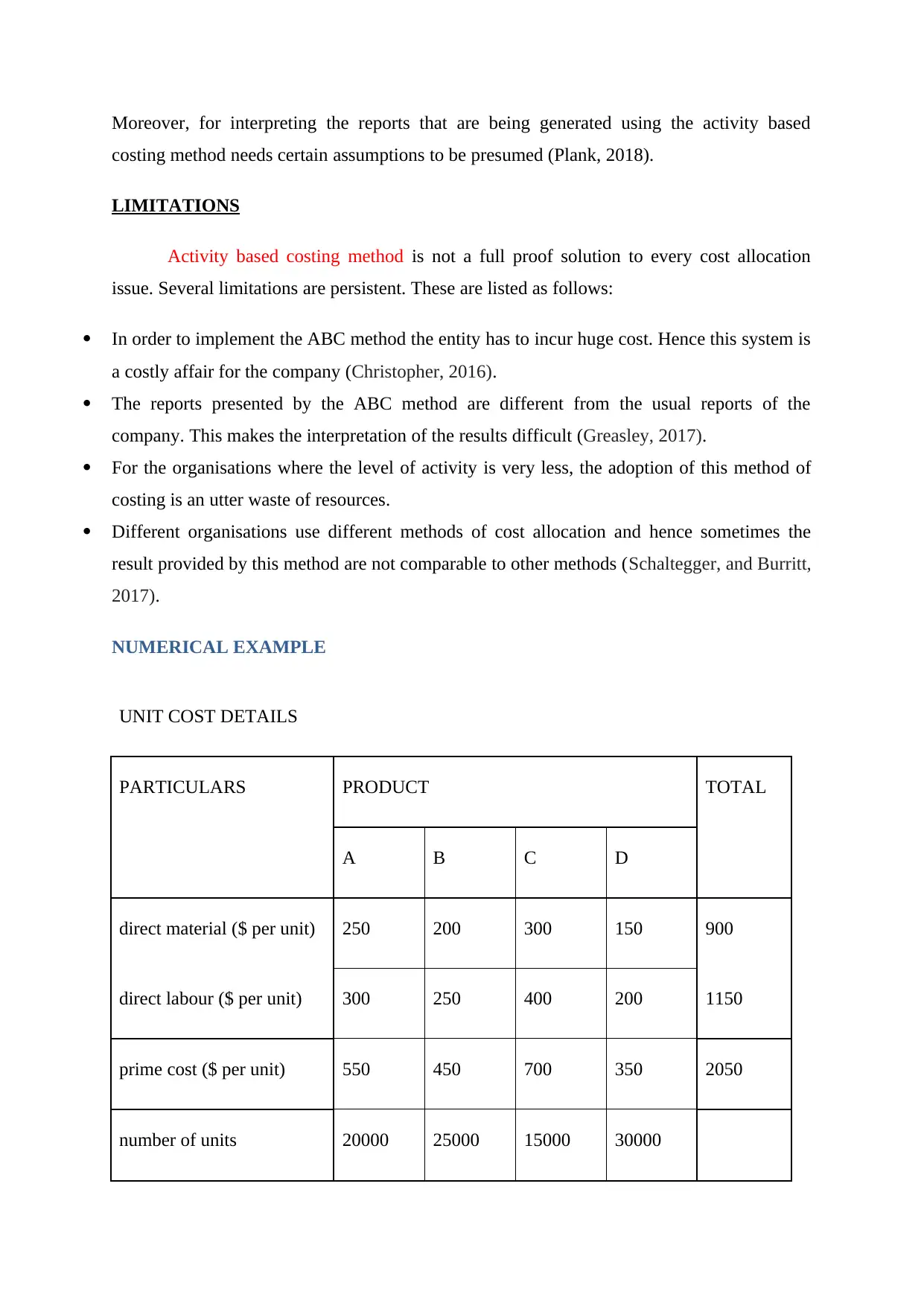
Moreover, for interpreting the reports that are being generated using the activity based
costing method needs certain assumptions to be presumed (Plank, 2018).
LIMITATIONS
Activity based costing method is not a full proof solution to every cost allocation
issue. Several limitations are persistent. These are listed as follows:
In order to implement the ABC method the entity has to incur huge cost. Hence this system is
a costly affair for the company (Christopher, 2016).
The reports presented by the ABC method are different from the usual reports of the
company. This makes the interpretation of the results difficult (Greasley, 2017).
For the organisations where the level of activity is very less, the adoption of this method of
costing is an utter waste of resources.
Different organisations use different methods of cost allocation and hence sometimes the
result provided by this method are not comparable to other methods (Schaltegger, and Burritt,
2017).
NUMERICAL EXAMPLE
UNIT COST DETAILS
PARTICULARS PRODUCT TOTAL
A B C D
direct material ($ per unit) 250 200 300 150 900
direct labour ($ per unit) 300 250 400 200 1150
prime cost ($ per unit) 550 450 700 350 2050
number of units 20000 25000 15000 30000
costing method needs certain assumptions to be presumed (Plank, 2018).
LIMITATIONS
Activity based costing method is not a full proof solution to every cost allocation
issue. Several limitations are persistent. These are listed as follows:
In order to implement the ABC method the entity has to incur huge cost. Hence this system is
a costly affair for the company (Christopher, 2016).
The reports presented by the ABC method are different from the usual reports of the
company. This makes the interpretation of the results difficult (Greasley, 2017).
For the organisations where the level of activity is very less, the adoption of this method of
costing is an utter waste of resources.
Different organisations use different methods of cost allocation and hence sometimes the
result provided by this method are not comparable to other methods (Schaltegger, and Burritt,
2017).
NUMERICAL EXAMPLE
UNIT COST DETAILS
PARTICULARS PRODUCT TOTAL
A B C D
direct material ($ per unit) 250 200 300 150 900
direct labour ($ per unit) 300 250 400 200 1150
prime cost ($ per unit) 550 450 700 350 2050
number of units 20000 25000 15000 30000
Paraphrase This Document
Need a fresh take? Get an instant paraphrase of this document with our AI Paraphraser
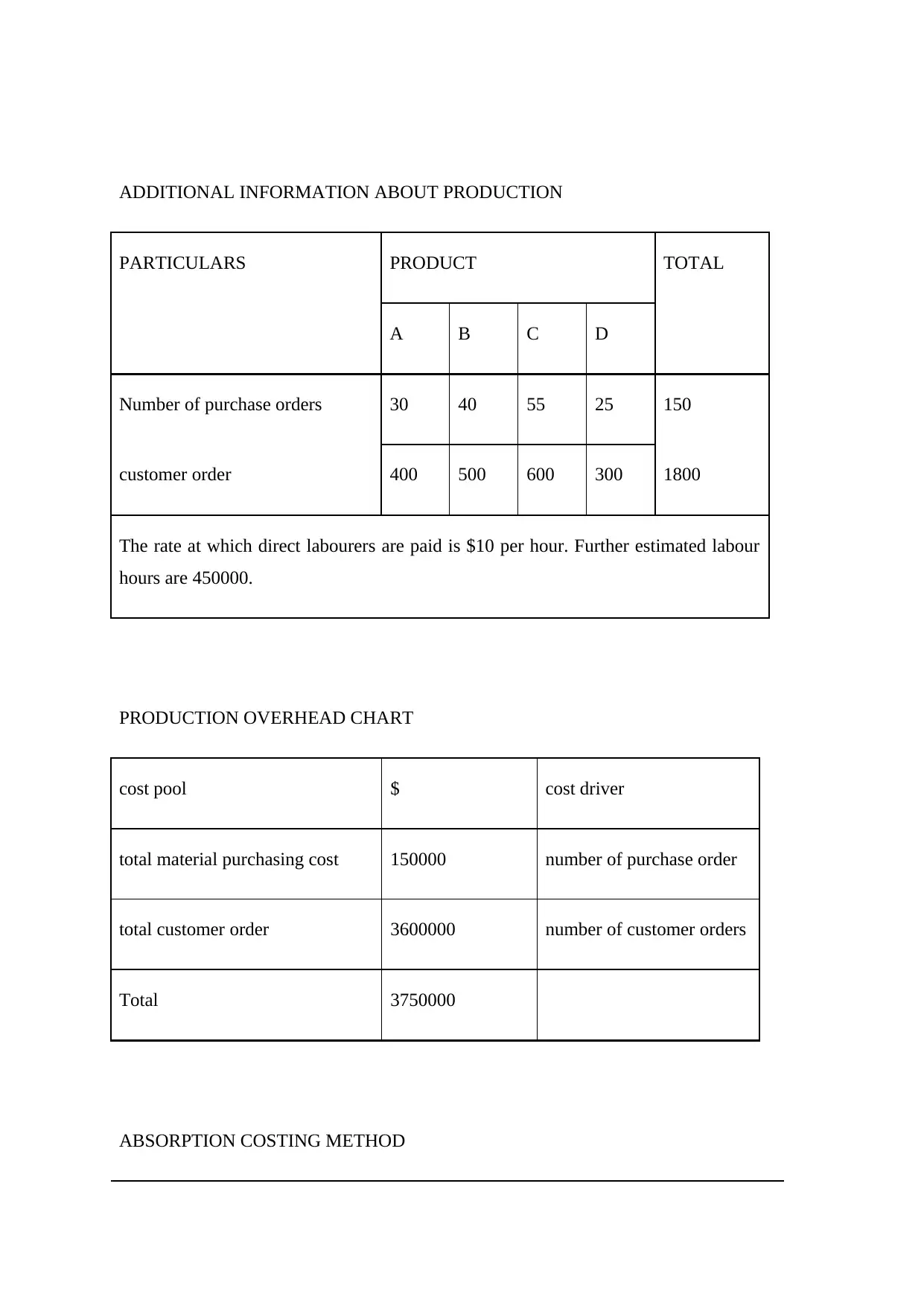
ADDITIONAL INFORMATION ABOUT PRODUCTION
PARTICULARS PRODUCT TOTAL
A B C D
Number of purchase orders 30 40 55 25 150
customer order 400 500 600 300 1800
The rate at which direct labourers are paid is $10 per hour. Further estimated labour
hours are 450000.
PRODUCTION OVERHEAD CHART
cost pool $ cost driver
total material purchasing cost 150000 number of purchase order
total customer order 3600000 number of customer orders
Total 3750000
ABSORPTION COSTING METHOD
PARTICULARS PRODUCT TOTAL
A B C D
Number of purchase orders 30 40 55 25 150
customer order 400 500 600 300 1800
The rate at which direct labourers are paid is $10 per hour. Further estimated labour
hours are 450000.
PRODUCTION OVERHEAD CHART
cost pool $ cost driver
total material purchasing cost 150000 number of purchase order
total customer order 3600000 number of customer orders
Total 3750000
ABSORPTION COSTING METHOD
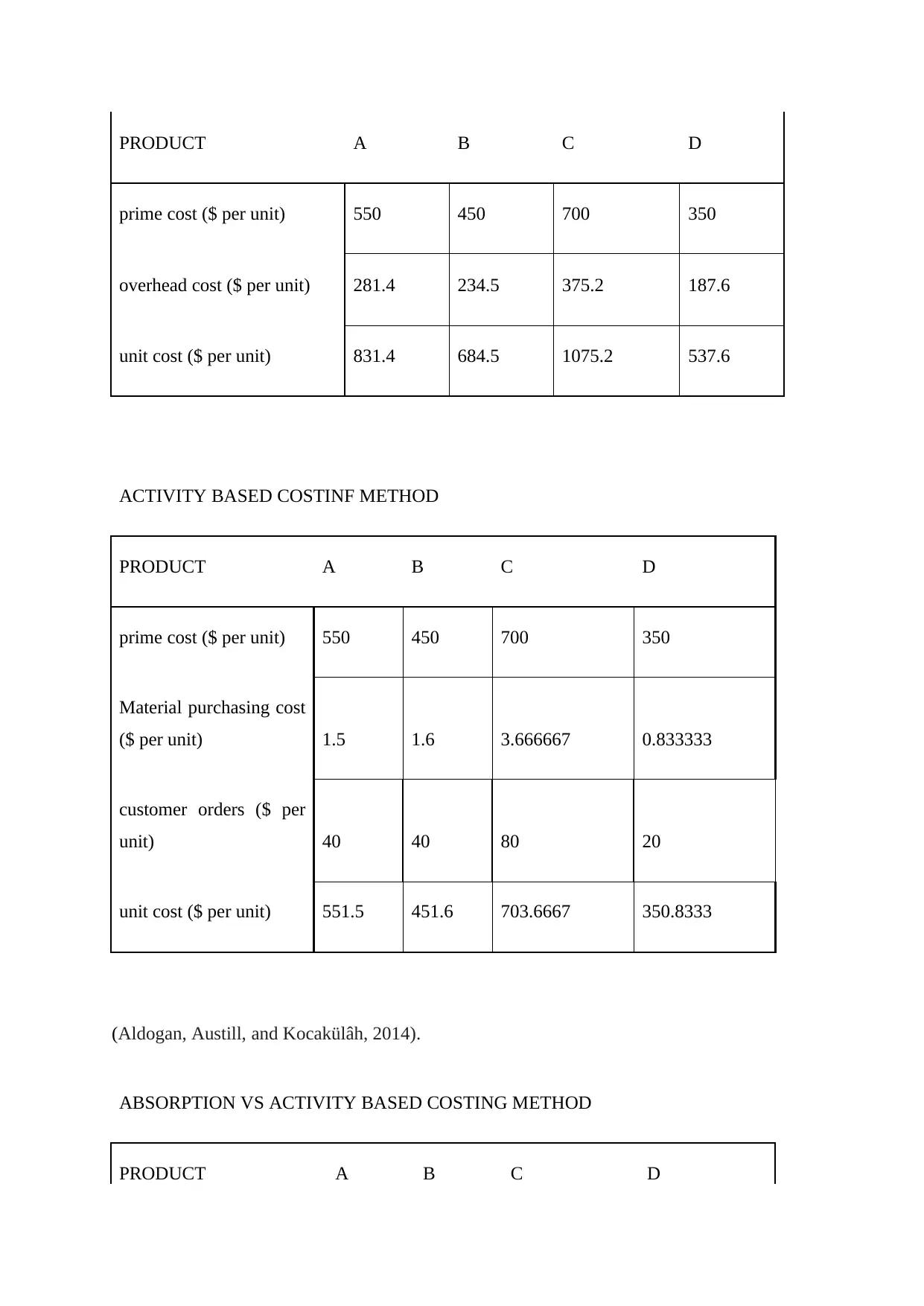
PRODUCT A B C D
prime cost ($ per unit) 550 450 700 350
overhead cost ($ per unit) 281.4 234.5 375.2 187.6
unit cost ($ per unit) 831.4 684.5 1075.2 537.6
ACTIVITY BASED COSTINF METHOD
PRODUCT A B C D
prime cost ($ per unit) 550 450 700 350
Material purchasing cost
($ per unit) 1.5 1.6 3.666667 0.833333
customer orders ($ per
unit) 40 40 80 20
unit cost ($ per unit) 551.5 451.6 703.6667 350.8333
(Aldogan, Austill, and Kocakülâh, 2014).
ABSORPTION VS ACTIVITY BASED COSTING METHOD
PRODUCT A B C D
prime cost ($ per unit) 550 450 700 350
overhead cost ($ per unit) 281.4 234.5 375.2 187.6
unit cost ($ per unit) 831.4 684.5 1075.2 537.6
ACTIVITY BASED COSTINF METHOD
PRODUCT A B C D
prime cost ($ per unit) 550 450 700 350
Material purchasing cost
($ per unit) 1.5 1.6 3.666667 0.833333
customer orders ($ per
unit) 40 40 80 20
unit cost ($ per unit) 551.5 451.6 703.6667 350.8333
(Aldogan, Austill, and Kocakülâh, 2014).
ABSORPTION VS ACTIVITY BASED COSTING METHOD
PRODUCT A B C D
⊘ This is a preview!⊘
Do you want full access?
Subscribe today to unlock all pages.

Trusted by 1+ million students worldwide
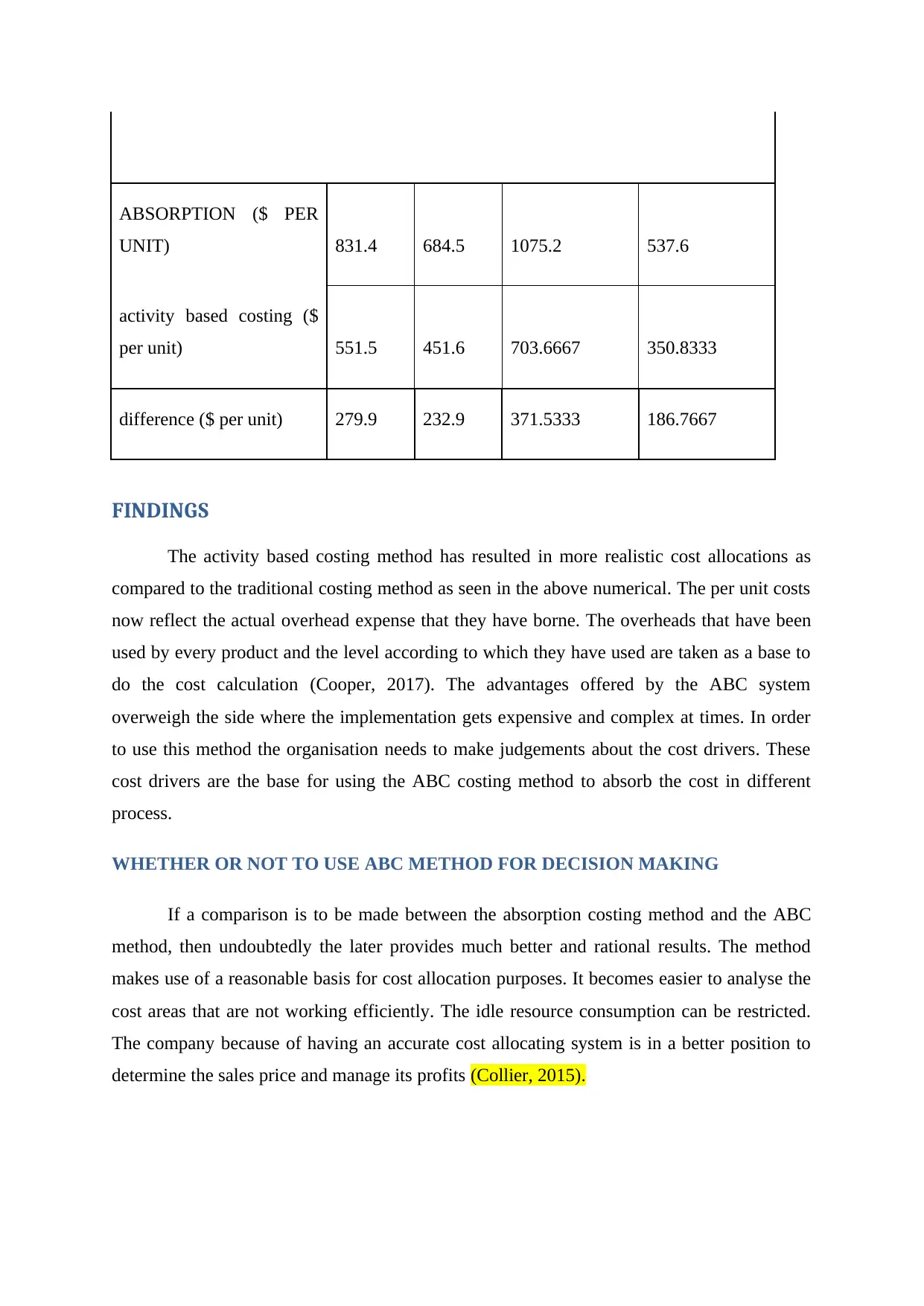
ABSORPTION ($ PER
UNIT) 831.4 684.5 1075.2 537.6
activity based costing ($
per unit) 551.5 451.6 703.6667 350.8333
difference ($ per unit) 279.9 232.9 371.5333 186.7667
FINDINGS
The activity based costing method has resulted in more realistic cost allocations as
compared to the traditional costing method as seen in the above numerical. The per unit costs
now reflect the actual overhead expense that they have borne. The overheads that have been
used by every product and the level according to which they have used are taken as a base to
do the cost calculation (Cooper, 2017). The advantages offered by the ABC system
overweigh the side where the implementation gets expensive and complex at times. In order
to use this method the organisation needs to make judgements about the cost drivers. These
cost drivers are the base for using the ABC costing method to absorb the cost in different
process.
WHETHER OR NOT TO USE ABC METHOD FOR DECISION MAKING
If a comparison is to be made between the absorption costing method and the ABC
method, then undoubtedly the later provides much better and rational results. The method
makes use of a reasonable basis for cost allocation purposes. It becomes easier to analyse the
cost areas that are not working efficiently. The idle resource consumption can be restricted.
The company because of having an accurate cost allocating system is in a better position to
determine the sales price and manage its profits (Collier, 2015).
UNIT) 831.4 684.5 1075.2 537.6
activity based costing ($
per unit) 551.5 451.6 703.6667 350.8333
difference ($ per unit) 279.9 232.9 371.5333 186.7667
FINDINGS
The activity based costing method has resulted in more realistic cost allocations as
compared to the traditional costing method as seen in the above numerical. The per unit costs
now reflect the actual overhead expense that they have borne. The overheads that have been
used by every product and the level according to which they have used are taken as a base to
do the cost calculation (Cooper, 2017). The advantages offered by the ABC system
overweigh the side where the implementation gets expensive and complex at times. In order
to use this method the organisation needs to make judgements about the cost drivers. These
cost drivers are the base for using the ABC costing method to absorb the cost in different
process.
WHETHER OR NOT TO USE ABC METHOD FOR DECISION MAKING
If a comparison is to be made between the absorption costing method and the ABC
method, then undoubtedly the later provides much better and rational results. The method
makes use of a reasonable basis for cost allocation purposes. It becomes easier to analyse the
cost areas that are not working efficiently. The idle resource consumption can be restricted.
The company because of having an accurate cost allocating system is in a better position to
determine the sales price and manage its profits (Collier, 2015).
Paraphrase This Document
Need a fresh take? Get an instant paraphrase of this document with our AI Paraphraser
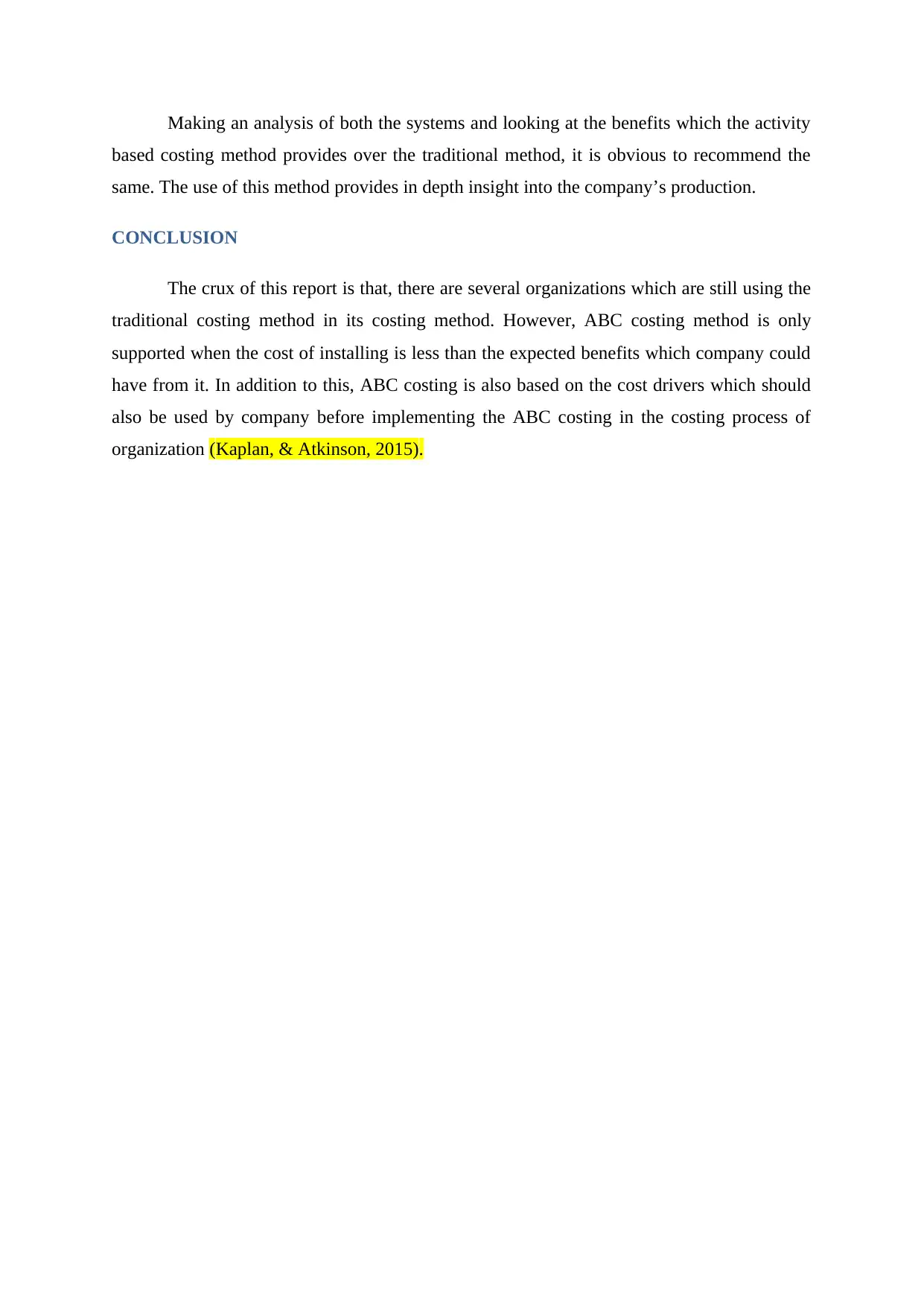
Making an analysis of both the systems and looking at the benefits which the activity
based costing method provides over the traditional method, it is obvious to recommend the
same. The use of this method provides in depth insight into the company’s production.
CONCLUSION
The crux of this report is that, there are several organizations which are still using the
traditional costing method in its costing method. However, ABC costing method is only
supported when the cost of installing is less than the expected benefits which company could
have from it. In addition to this, ABC costing is also based on the cost drivers which should
also be used by company before implementing the ABC costing in the costing process of
organization (Kaplan, & Atkinson, 2015).
based costing method provides over the traditional method, it is obvious to recommend the
same. The use of this method provides in depth insight into the company’s production.
CONCLUSION
The crux of this report is that, there are several organizations which are still using the
traditional costing method in its costing method. However, ABC costing method is only
supported when the cost of installing is less than the expected benefits which company could
have from it. In addition to this, ABC costing is also based on the cost drivers which should
also be used by company before implementing the ABC costing in the costing process of
organization (Kaplan, & Atkinson, 2015).
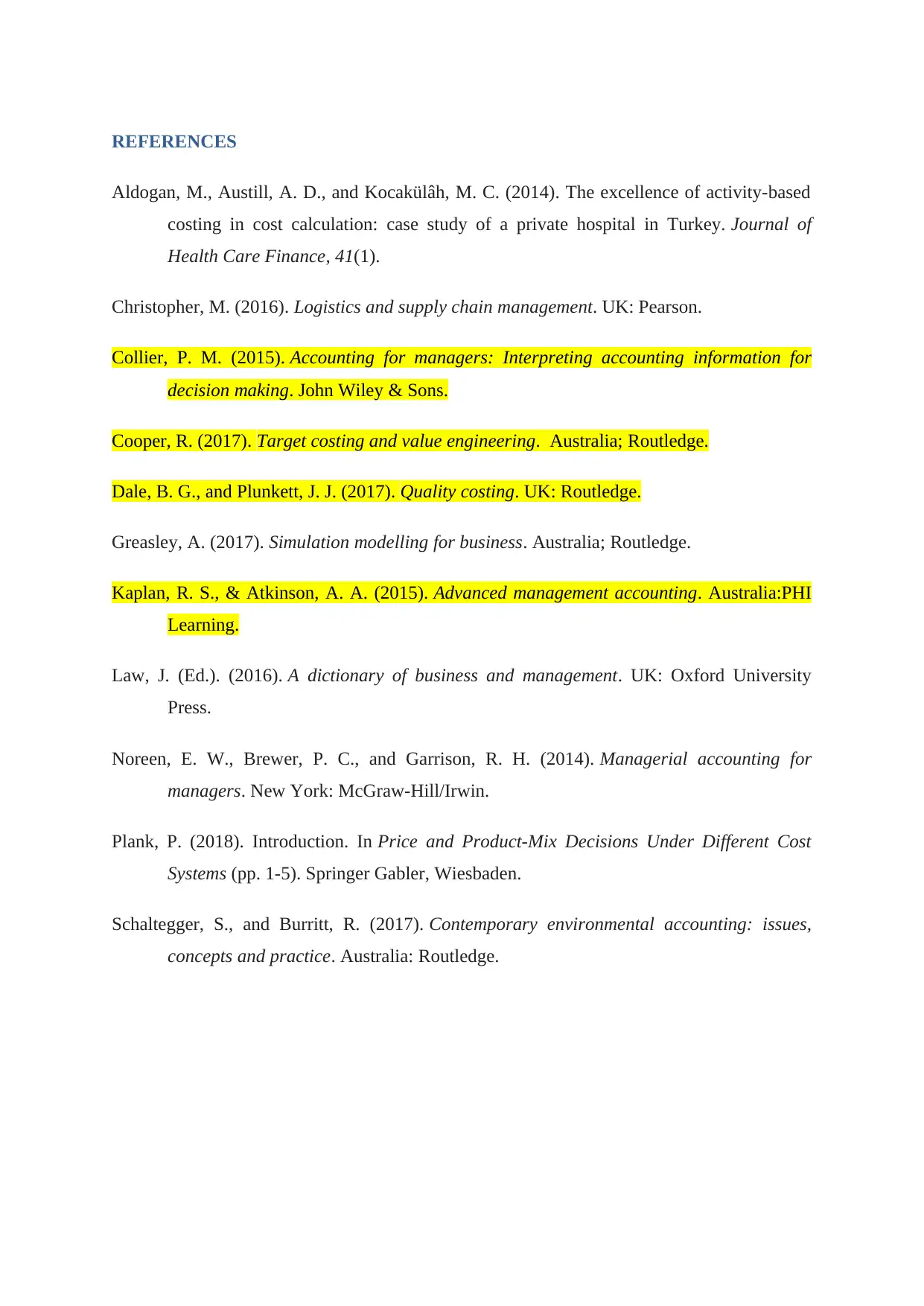
REFERENCES
Aldogan, M., Austill, A. D., and Kocakülâh, M. C. (2014). The excellence of activity-based
costing in cost calculation: case study of a private hospital in Turkey. Journal of
Health Care Finance, 41(1).
Christopher, M. (2016). Logistics and supply chain management. UK: Pearson.
Collier, P. M. (2015). Accounting for managers: Interpreting accounting information for
decision making. John Wiley & Sons.
Cooper, R. (2017). Target costing and value engineering. Australia; Routledge.
Dale, B. G., and Plunkett, J. J. (2017). Quality costing. UK: Routledge.
Greasley, A. (2017). Simulation modelling for business. Australia; Routledge.
Kaplan, R. S., & Atkinson, A. A. (2015). Advanced management accounting. Australia:PHI
Learning.
Law, J. (Ed.). (2016). A dictionary of business and management. UK: Oxford University
Press.
Noreen, E. W., Brewer, P. C., and Garrison, R. H. (2014). Managerial accounting for
managers. New York: McGraw-Hill/Irwin.
Plank, P. (2018). Introduction. In Price and Product-Mix Decisions Under Different Cost
Systems (pp. 1-5). Springer Gabler, Wiesbaden.
Schaltegger, S., and Burritt, R. (2017). Contemporary environmental accounting: issues,
concepts and practice. Australia: Routledge.
Aldogan, M., Austill, A. D., and Kocakülâh, M. C. (2014). The excellence of activity-based
costing in cost calculation: case study of a private hospital in Turkey. Journal of
Health Care Finance, 41(1).
Christopher, M. (2016). Logistics and supply chain management. UK: Pearson.
Collier, P. M. (2015). Accounting for managers: Interpreting accounting information for
decision making. John Wiley & Sons.
Cooper, R. (2017). Target costing and value engineering. Australia; Routledge.
Dale, B. G., and Plunkett, J. J. (2017). Quality costing. UK: Routledge.
Greasley, A. (2017). Simulation modelling for business. Australia; Routledge.
Kaplan, R. S., & Atkinson, A. A. (2015). Advanced management accounting. Australia:PHI
Learning.
Law, J. (Ed.). (2016). A dictionary of business and management. UK: Oxford University
Press.
Noreen, E. W., Brewer, P. C., and Garrison, R. H. (2014). Managerial accounting for
managers. New York: McGraw-Hill/Irwin.
Plank, P. (2018). Introduction. In Price and Product-Mix Decisions Under Different Cost
Systems (pp. 1-5). Springer Gabler, Wiesbaden.
Schaltegger, S., and Burritt, R. (2017). Contemporary environmental accounting: issues,
concepts and practice. Australia: Routledge.
⊘ This is a preview!⊘
Do you want full access?
Subscribe today to unlock all pages.

Trusted by 1+ million students worldwide
1 out of 9
Related Documents
Your All-in-One AI-Powered Toolkit for Academic Success.
+13062052269
info@desklib.com
Available 24*7 on WhatsApp / Email
![[object Object]](/_next/static/media/star-bottom.7253800d.svg)
Unlock your academic potential
Copyright © 2020–2025 A2Z Services. All Rights Reserved. Developed and managed by ZUCOL.


